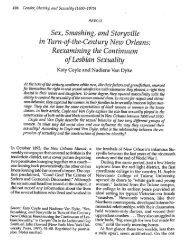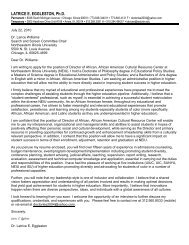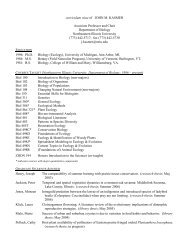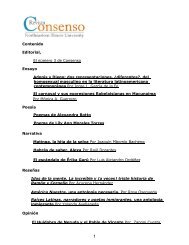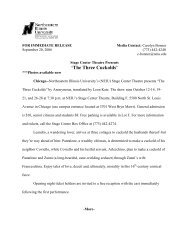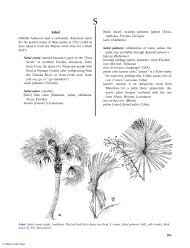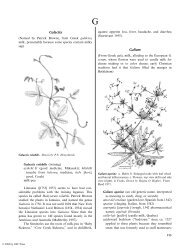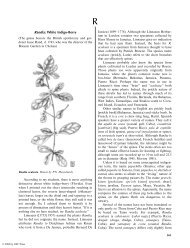Herba Cana - Northeastern Illinois University
Herba Cana - Northeastern Illinois University
Herba Cana - Northeastern Illinois University
You also want an ePaper? Increase the reach of your titles
YUMPU automatically turns print PDFs into web optimized ePapers that Google loves.
© 2004 by CRC Press<br />
554 Florida Ethnobotany<br />
Pycnanthemum albescens. From Britton and Brown 1898.<br />
Pycnanthemum albescens (whitish)<br />
sak:fotó [iska fotó] (Koasati; probably cognate<br />
with Creek kvfockv [kafócka]; cf. Piloblephis)<br />
shinuktiɬ eli [shinuktelele] (shinuk, sand [probably<br />
originally shilup, ghost], tiɬ eli, to drive out,<br />
Choctaw; this name is a variant of the one<br />
used for Monarda punctata, which see)<br />
white [white-leaf] mountain-mint [whiteleaf mountainmint]<br />
Pycnanthemum flexuosum (curved alternately in<br />
opposite directions)<br />
Appalachian mountain-mint [mountainmint]<br />
dysentery weed<br />
My education about Pycnanthemum began when I<br />
was working with my undergraduate professor Gordon<br />
Hunter. He had become interested in the mints<br />
and hired me in the 1960s to collect and work with him<br />
on some of the problems in the western Kentucky<br />
species. I knew the plants in the Jackson Purchase<br />
region of Kentucky between the Tennessee and Mississippi<br />
Rivers, but he had me look more closely at<br />
them. During the time that I was gathering specimens<br />
for him, I did not know that they had a long and<br />
complicated history of association with people.<br />
An early mention of what is now P. virginianum,<br />
published in 1697 by Paulo Boccone (1633 /1703/04),<br />
an Italian monk, physician, and professor at Padua,<br />
alludes to its medical application. He called the plants<br />
Serpentaria virginianus (Virginia snakeroot), and<br />
plants with that name were considered remedies for<br />
snakebite. That common name has been applied to<br />
numerous plants in different genera over the past few<br />
centuries (cf. also Aristolochia).<br />
In 1696, Leonard Plukenet discussed the same<br />
species, but he gave it the phrase name Clinopodium,<br />
pulegii angusto rididoque foliio, virginianum (Clinopodium,<br />
with narrow and rigid leaves like pulegium<br />
[pennyroyal], from Virginia). Both Jan Gronovius’s<br />
Flora Virginica and Linnaeus’s Hortus Cliffortianus<br />
followed Plukenet’s lead in thinking the herbs were a<br />
Clinopodium, but another early student of the herbs<br />
thought differently. In his 1699 book, Robert Morrison<br />
emphasized that the Virginia plants should be a<br />
distinct species of Pulegium. After further study,<br />
Linnaeus changed his mind, and in 1753 he called<br />
the plants Satureja virginiana. Thus, in the first 57<br />
years that single species had been known, it had been<br />
placed in four genera. People are still debating<br />
placement of many species in the Lamiaceae, as genera<br />
of mints remain problematical. However, most now<br />
agree that the species discussed from Plukenet to<br />
Linnaeus is Pycnanthemum, a genus created by Michaux<br />
in 1803. We now know of 17 species endemic to<br />
North America (Mabberley 1997).<br />
Indigenous people in the eastern United States<br />
have long been familiar with Pycnanthemum. People<br />
from the Ojibwa of southern <strong>Cana</strong>da to the Cherokee<br />
of the Carolinas are recorded as using the plants in<br />
seasoning food (Densmore 1928, Hamel and Chiltoskey<br />
1975). As Fernald et al. (1958) noted, most of the<br />
aromatic mints have been used as food additives to<br />
improve flavors. The common name ‘‘basil’’ or ‘‘American<br />
wild basil’’ widely applied to Pycnanthemum<br />
alludes to a more widespread application in seasoning<br />
food than most literature suggests. It is known that P.<br />
muticum contains several volatile oils including pulegone,<br />
menthol, menthone, and limonene; presumably<br />
all species contain different mixtures of those aromatic<br />
compounds (Hocking 1997). Porcher (1862) was<br />
especially complimentary to the family when he wrote<br />
that it does ‘‘not contain a single unwholesome or even<br />
suspicious species; their tonic, cordial, and stomachic<br />
qualities are due ... to the presence of an aromatic,<br />
volatile oil, and a bitter principle.’’<br />
Medicine and food blend in most cultures so that<br />
it is not always possible to distinguish one from the<br />
other. However, several tribes considered different<br />
species of Pycnanthemum a good remedy for colds<br />
(Moerman 1998). Foster and Duke (1990) say that all<br />
species were used interchangeably.<br />
In the southeastern United States, the Choctaw<br />
used a leaf decoction to promote sweating in treatment<br />
of colds (Bushnell 1909, Taylor 1940). The Koasati put<br />
the whole P. albescens plant in water, then used it to<br />
stop nosebleed. Roots mixed with those of Salix nigra<br />
were boiled, and the decoction drunk to relieve<br />
headache (Taylor 1940). To relieve contagion of death<br />
(onalfapó) leaves were put in cold water and the<br />
resulting mixture drunk and used to bathe the body<br />
while facing east (Kimball 1994). The Choctaw, the





